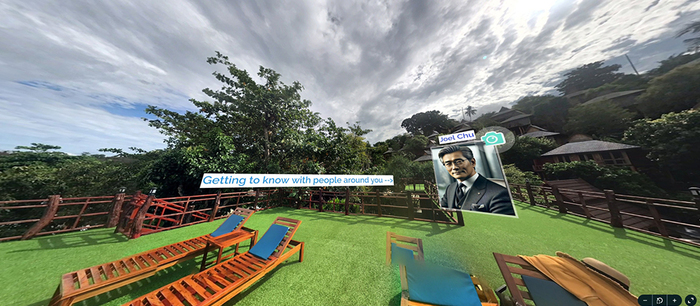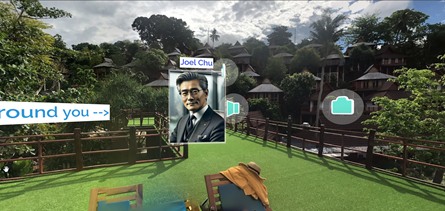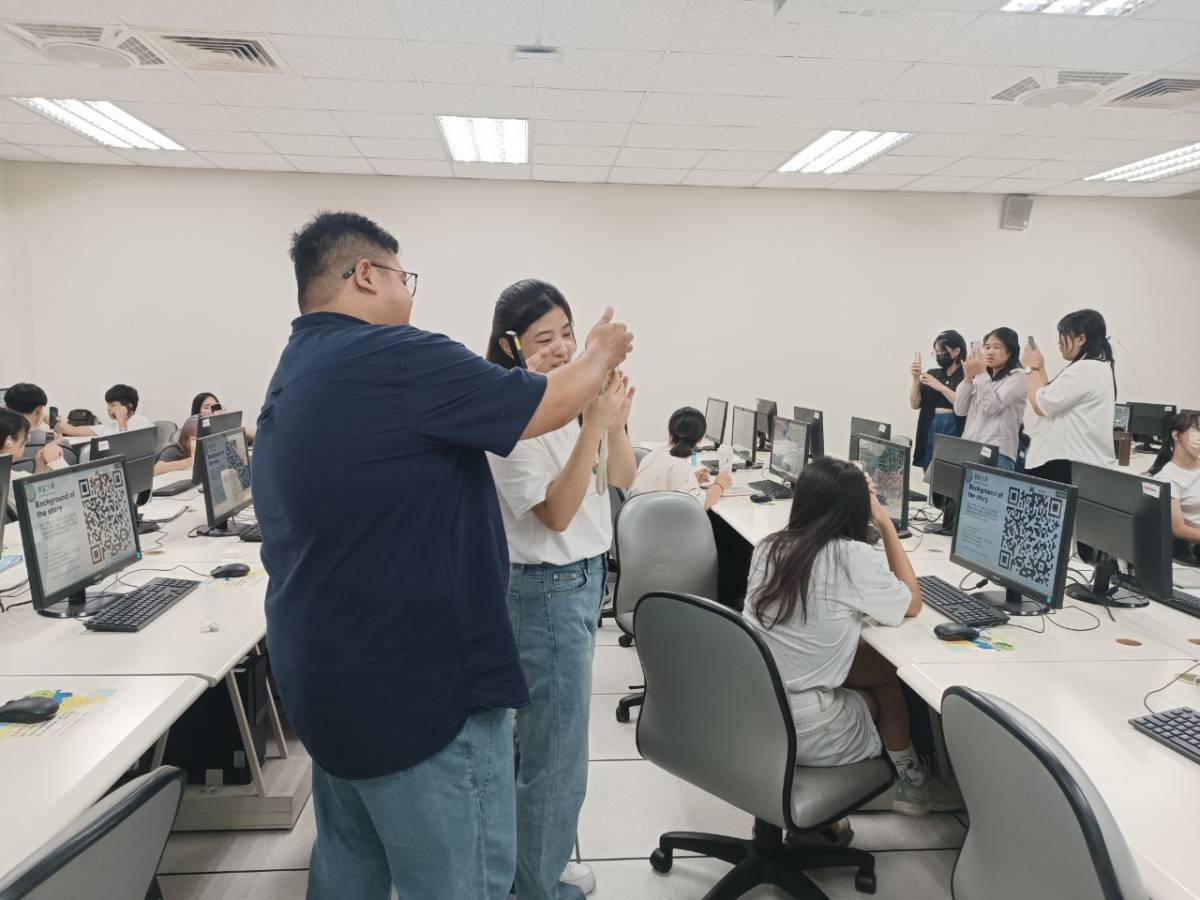


在當今瞬息萬變的教育環境中,科技已成為一股強大的力量,特別是在台灣,深深根植於社會的各個層面。隨著政府推動的「5G新科技學習示範學校計畫」,教育部引導教師充分運用5G行動通訊網路及各種學習載具,結合虛擬實境(Virtual Reality, VR)教材與元宇宙平台,實施創新教學,這些舉措進一步凸顯了VR技術在教育中的重要性。
隨著VR在台灣課堂中的普及,將其融入教師教育計劃變得尤為重要。環景影像虛擬實境(Spherical Video-Based Virtual Reality, SVVR)因為能讓學生沉浸在多元互動的環境中,讓他們能透過親身體驗和探索來學習,受到廣泛關注。在這一背景下,仍在職前培訓的教師需要學習如何設計和運用SVVR,以促進更具吸引力的參與式學習。掌握SVVR的運用,將能有效提升學生的參與度和學習效果,這不僅能提高整體教學品質,還能為未來的學習環境奠定基礎。
SVVR 符合 David Kolb提出的體驗式學習理論。根據 Kolb 的理論,有效的學習發生在一個涉及具體經驗、反思性觀察、抽象概念化和積極實驗的循環過程中(Kolb,1984)。簡單來說,當學生積極參與真實體驗、反思它們、形成新想法,然後嘗試這些想法時,學習才最有影響力。SVVR 是這種方法的理想工具,因為它允許學習者以傳統教學方法無法比擬的動手方式與教材內容進行互動。
想像一下在外語課上,學生們在餐廳練習點餐。在傳統的課堂中,他們可能會透過聽講或閱讀教科書來學習這項技能。然而,在 SVVR環境中,他們可以「進入」虛擬餐廳,與虛擬角色或真人互動,並在真實的餐廳情境中練習社交交流。這種學習方式鼓勵學生積極參與和深入思考,幫助他們與學習材料建立真實的聯繫。透過使用 SVVR,職前教師可以將這類體驗帶入他們未來的課堂,確保學生能夠從 Kolb 理論所提倡的沉浸式學習中受益。(見圖 1)。
對於職前教師來說,學習設計和實施 SVVR 體驗不僅僅是掌握新技術,更是創造身臨其境、以學生為中心的學習方式,與現今熟悉數位技術的學生產生共鳴。台灣作為全球技術的先驅,這一代人對數位工具非常感興趣。透過將 SVVR 納入台灣的課堂,未來的教育工作者可以縮短期望差距,提供吸引學生注意力並激發好奇心的課程。這種方法能帶來更有意義的學習體驗,並鼓勵探究和探索的文化。
SVVR 還為學生提供了一個獨特的機會,讓他們可以嘗試、犯錯和學習,而不會產生現實世界的後果。這在醫療或工程等領域特別有價值,因為這些領域中的現實錯誤可能會帶來嚴重後果(Chang & Hwang,2023)。例如,針對科學教育者的職前教師培訓可以創建學生進行實驗的實驗室環境的 SVVR 模擬。如果發生錯誤,學生可以安全地從中學習,從而強化體驗式學習理論核心的「邊做邊學」概念(參見 Konak et al.,2014)。這種動手實踐有助於學生掌握複雜的概念並建立應用知識的信心。
為了讓職前教師充分發揮SVVR的潛力,建議採取幾項策略。首先,應該在教師教育課程中及早引入透過SVVR進行的體驗式學習(見圖2)。當職前教師以學生的身份參與SVVR學習時,他們能夠親身體會其對學習參與和效果的影響。例如靜宜大學寰宇外語教育學士學位學程在基礎課程中納入SVVR模組,提供未來想成為外語教師的學生一個良好的起點。此外,專注於SVVR設計和教學法的課程也十分重要,因為創建互動式的SVVR環境需要教學知識與技術技能。實務工作坊和專案可以幫助職前教師設計與課程目標相符的沉浸式情境,並促進學生的主動參與。這些課程還應強調協作和反思活動,這兩者是體驗式學習的關鍵要素,以最大化SVVR在教室中的效益。
總之,隨著教育環境日益活躍且技術進步,讓職前教師具備在課堂上設計和實施SVVR的能力顯得尤為重要。SVVR透過體驗式學習的原則,成為創造引人入勝且有效的學習體驗的強大工具,超越了傳統教學方法。對於教育領域的專業人士和研究者而言,挑戰與機遇在於如何將SVVR整合進教師教育計畫,培養出一代能夠充分運用這項技術的台灣教師。在這個過程中,我們不僅培養了當今的教師,也激勵著未來的學習者。
文 / 寰宇外語學士學位學程 Darmawansah 達馬萬老師
翻譯 / 寰宇外語學士學位學程 王岱伊主任

圖1. SVVR 環境中的示例場景
Figure 1 Sample scene in the SVVR environment

圖2. 在數位化教育課程中,職前教師通過他們的個人設備探索了 SVVR 環境
Figure 2. Pre-service teachers explored the SVVR environment through their personal devices in the Digitalized Education course
《原文》
Training Taiwan’s pre-service teachers to design and employ a spherical video virtual reality: Why and how?
by: Darmawansah
In today’s rapidly changing educational world, technology has become a powerful force, especially in Taiwan, where it is deeply embedded in society. Among the advanced tools available, spherical video virtual reality (SVVR) stands out for its ability to immerse students in rich, interactive environments that enable them to learn through direct experience and exploration. As virtual reality becomes more common in classrooms across Taiwan, integrating it into teacher education programs is essential. Pre-service teachers, those still in the teachers education program, need to learn how to design and use SVVR for engaging, hands-on learning, as it boosts student involvement and leads to more effective learning outcomes.
The educational potential of SVVR is strongly supported by experiential learning theory, as pioneered by David Kolb. According to Kolb’s theory, effective learning happens through a cycle involving concrete experience, reflective observation, abstract conceptualization, and active experimentation (Kolb, 1984). In simpler terms, learning is most impactful when students actively engage with real experiences, reflect on them, form new ideas, and then try these ideas out. SVVR is an ideal tool for this approach, as it allows learners to interact with content in a hands-on way that traditional teaching methods cannot match.
For example, imagine a foreign language lesson where students practice ordering food in a restaurant. In a traditional classroom, they might learn this skill through lectures or textbook readings. In an SVVR setting, however, they can "dive" into a virtual restaurant, interact with virtual avatars or real people, and practice the social exchanges of a restaurant setting in real-time. This type of learning encourages students to actively participate and think deeply, helping them connect authentically with the material. By using SVVR, pre-service teachers can bring such experiences into their future classrooms, ensuring that students benefit from the immersive learning that Kolb’s theory advocates (see Figure 1).
Figure 1 Sample scene in the SVVR environment
For pre-service teachers, learning to design and implement SVVR experiences isn’t just about mastering new technology. It’s about creating immersive, student-centered learning that resonates with today’s digitally familiar students. Taiwan is a global pioneer in technology, and its current generation is highly interested in digital tools. By incorporating SVVR into Taiwan’s classrooms, future educators can bridge the expectation gap, providing lessons that capture students' attention and stimulate curiosity. This approach can result in more meaningful learning experiences, encouraging a culture of inquiry and exploration.
SVVR also offers students a unique opportunity to experiment, make mistakes, and learn without real-world consequences. This feature is especially valuable in fields like healthcare or engineering, where real-world errors could have serious outcomes (Chang & Hwang, 2023). For instance, a pre-service teacher training to become a science educator could create a SVVR simulation of a lab environment where students conduct experiments. If mistakes occur, students can learn from them safely, reinforcing the concept of “learning by doing” that is central to experiential learning theory (see Konak et al., 2014). This hands-on practice helps students grasp complex concepts and builds their confidence in applying knowledge.
To ensure pre-service teachers can fully leverage the potential of SVVR, a few strategies are recommended. First, experiential learning through SVVR should be introduced early in teacher education programs (see Figure 2). By engaging with SVVR-based learning as students themselves, pre-service teachers develop a firsthand understanding of its impact on engagement and learning. Including SVVR modules in foundational courses provides a strong starting point. Additionally, courses focused on SVVR design and pedagogy are essential, as creating interactive SVVR environments requires both teaching knowledge and technical skills. Practical workshops and projects can help pre-service teachers design immersive scenarios that align with curriculum goals and encourage active student engagement. These courses should also emphasize collaborative and reflective activities, both crucial elements of experiential learning, to maximize SVVR’s benefits in the classroom.
Figure 2. Pre-service teachers explored the SVVR environment through their personal devices in the Digitalized Education course
In conclusion, equipping pre-service teachers with the skills to design and implement SVVR in the classroom is essential as educational environments become more dynamic and technologically advanced. By leveraging the principles of experiential learning, SVVR offers a powerful tool for creating engaging and effective learning experiences that go beyond traditional methods. For practitioners and researchers in the field of education, the challenge and opportunity lie in integrating SVVR into teacher education programs, fostering a generation of Taiwan’s teachers ready to harness its capabilities. In doing so, we prepare today’s teachers to inspire tomorrow’s learners.
◎參考 References
Chang, C. C., & Hwang, G. J. (2023). An experiential learning-based virtual reality approach to fostering problem-resolving competence in professional training. Interactive Learning Environments, 31(8), 4713-4728.
Kolb, D. A. (1984). Experiential learning: Experience as the source of learning and development. Prentice Hall.
Konak, A., Clark, T. K., & Nasereddin, M. (2014). Using kolb’s experiential learning cycle to improve student learning in virtual computer laboratories. Computers & Education, 72,11–22. https://doi.org/10.1016/j.compedu.2013.10.013